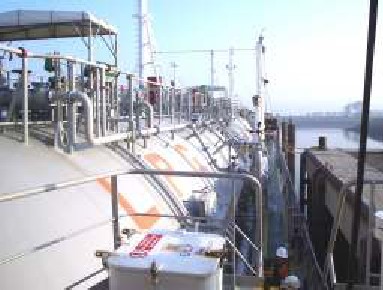Fig:Fully pressurized LPG carrier at sea
Type 'C' tanks are designed and built to conventional pressure vessel codes and, as a result, can be subjected to accurate stress analysis. Furthermore, design stresses are kept low. Accordingly, no secondary barrier is required for Type 'C' tanks and the hold space can be filled with either inert gas or dry air and for fully pressurised tankers normal air may be allowed.
In the case of a typical fully pressurised tanker (where the cargo is carried at ambient temperature), the tanks may be designed for a maximum working pressure of about 18 barg. For a semi-pressurised tanker the cargo tanks and associated equipment are designed for a working pressure of approximately 5 to 7 barg and a vacuum of 0.3 barg.
Advantages of fully pressurized tankers:
i) They are built with ordinary grades of steel as the cargo is carried at ambient temperature and no insulation is required
ii) no reliquefaction plant is required
iii) operations are simpler
Disadvantages
i) Due to their shape, the use of underdeck space cannot be optimised
ii) high design pressure requires considerable tank wall thickness, with consequent increase in displacement weight and cost
iii) the weight in tons of cargo carried is lower than for a refrigerated ship of similar size, due to cargo density difference

Fig:Fully pressurized LPG carrier
Related Information:
- Carrying by ethylene carriers
- Carrying liquefied gases by semi pressurized ships
- The sea transport of bulk liquefied gases by fully refrigerated ships
Transporting liquefied natural gases by LNG ships
Liquefied gas carrier safety training
Benifits of compressed gas technology
Compressed gas liquid carriers (CGLC)
Development and potential of todays emerging gas technologies
Transporting economically viable compressed gas liquids from remote fields Benifits of compressed gas technology
Increased cargo capacity for LNG ships & advantages of the dual fuel diesel electric propulsion
Transporting liquefied natural gases by LNG ships
Gas cargo containment systems - primary barrier (the cargo tank),secondary barrier, thermal insulation and more
External links :
// Home page/// LNG handling /// LPG handling/// Sea transport /// Gas products///
Cargo work ///Fire precautions ///Health hazards ///Safety Precautions
///Emergency response ///
Copyright © Liquefied Gas Carrie.com All rights reserved.
The content published in this website are for general reference only. We have endeavoured to make the information as accurate as possible but cannot take responsibility for any errors. For latest information please visit www.imo.org . Any suggestions, please Contact us !
///Links &Resources // Terms of use/// Privacy policy///Home page///